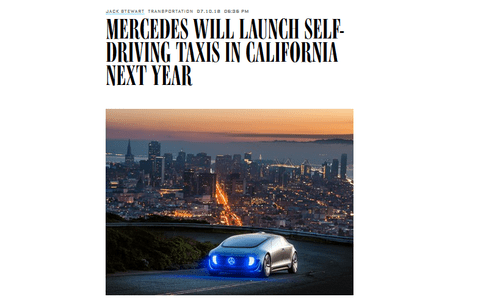>While there are skeptics about the self-driving project who think it will require more time and testing to materialize, top corporations are taking concrete steps to move forward. Billion-dollar companies see autonomous vehicles as the future of transportation and they don’t want to be left behind.
Two major automakers have recently announced their intention to launch automated taxi services in California. That’s a smart move for a couple reasons, one being a smaller scale arena to work the kinks out.
![]()
Another topic that must concern the auto companies is the public’s apprehension about having a machine operating the car. A January Reuter/Ipsos poll found that two-thirds of Americans are uncomfortable about the idea of riding in a self-driving car. A Gallup survey released in February determined that 54 percent of Americans said they are unlikely to utilize self-driving cars.
So a gradual introduction of self-driving technology via taxis would make sense along with a marketing program of advertising and social media. For example, Intel ran an ad last fall showing basketball star Lebron James overcoming his aversion toward a driverless car. Online coupons for a cheaper ride would entice some. Local news stories about the new taxis will likely be promoted when they get going.
Of course, the proponents of the new automation technology rarely mention the associated job loss, as the less expensive machines replace pricey humans who also need lunch breaks and healthcare. A Bureau of Labor Statistics page for Taxi Drivers, Ride-Hailing Drivers, and Chauffeurs put the number of workers at 305,100 for 2016. In addition, there are millions of Americans who work as drivers: in 2015, the Department of Commerce reported that there were 3.8 million motor vehicle operators:
![]()
Interestingly, a 2013 paper from CIS.org noted that 42 percent of taxi drivers and chauffeurs are foreign born, so continuing to import low-skilled immigrants appears unwise, to say the least. For example, the Central Americans now mobbing the border and making fake asylum claims don’t bring any useful skills. Low-skilled jobs that Centrals could do — like restaurant work and agriculture — are the ones most likely to get robot replacements in the near future if they haven’t been transformed already.
Okay, back to robo-taxis coming to California; tech-friendly San Francisco is getting a General Motors installation:
GM puts pieces in place for self-driving taxis in San Francisco Los Angeles Times, July 3, 2018
General Motors Co. has created its own ride-hailing platform and quietly built one of the largest charging stations in the United States to get its Cruise self-driving car unit ready to enter the robo-taxi business next year.
Cruise has installed 18 fast chargers in a parking facility near San Francisco’s Embarcadero, the well-trafficked boulevard along the city’s eastern shoreline where Uber Technologies Inc. and Lyft Inc. have busy drivers. And GM’s self-driving car unit has been testing its own Cruise Anywhere ride-hailing app and fleet-management system, said people familiar with the matter.
The largest U.S. automaker has long planned to start a ride-hailing business using self-driving cars by 2019, but it hasn’t said where the service would start or whether it would work with a partner. These latest moves show that San Francisco is where GM is assembling the pieces to launch its rival to Alphabet Inc.’s Waymo next year if GM decides against working with an established livery app such as Uber or Lyft. (Continues)
Meanwhile, Daimler is eyeballing wealthy Silicon Valley for a rollout of deluxe Mercedes shuttles.
Mercedes Will Launch Self-Driving Taxis in California Next Year, Wired, July 10, 2018
LIKE IN A Tough Mudder, you’ve got a few strategies when it comes to the race to launch a taxi-like service with autonomous vehicles. You can start early and keep a slow but steady pace. You can show up a bit late, then try to sprint through it. Or you can hold back, see what trips up other contenders, and then slowly work your way through the obstacles.
The big automakers tend to fall into the third category. They may have taken a few years to recognize that shared autonomous vehicles could annihilate their business model—selling human-driven cars to individual humans—but they’re now making real progress toward the finish line. And today, Mercedes-Benz parent company Daimler took a cautious step into the swamp stomp, announcing plans to launch a self-driving car pilot somewhere in Silicon Valley, next year.
Daimler is calling its service an “automated shuttle,” but it’s not referring to some blobby, slow-moving van. It’s going to start out using a fleet of S-Class luxury sedans and B-Class hatchbacks, with long-term plans for vehicles designed for autonomous driving, like the F 015 “Luxury in Motion” concept it showed off a few years back.
The automaker is still negotiating the particulars of the deal, has not divulged which city will host this program, and being cagey on details like how many cars will make up the robo-fleet. It does plan to have human safety drivers on board to keep an eye on the system. Passengers, who will request rides via an app, will travel for free. The Germans are more open about the lessons they’ve learned watching the self-driving car industry start to take shape, including the myriad complexities of the challenge. “Hardly any company can meet this challenge alone,” says Uwe Keller, Daimler’s head of autonomous driving. (Continues)















